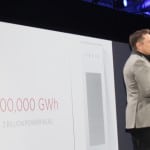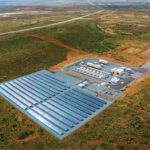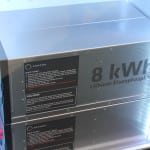Although many observers consider Elon Musk—the visionary entrepreneur who leads Tesla Motors and SpaceX—to be a disruptive force threatening the conventional power industry, he believes power companies have a bright future, if his goal to expand the use of electric cars and install vast numbers of rooftop solar systems is achieved.
Speaking during a presentation to roll out Tesla’s Powerwall 2 battery-storage system and a new rooftop solar tile product line, Musk said, “Sometimes the solar roof is positioned as sort of a competitor to utilities, but we’re actually going to need utility power to increase and we’re going to need local power generation. Because if you transition all energy to electric, that roughly triples the amount of electricity that is needed.”
Musk suggested that about a third of the electricity would be used for transportation, about a third for heating, and about a third for what is already being supplied by the grid, if his vision is realized. “The solution is both local power generation and utility generation, it’s not one or the other,” Musk said.
Musk believes the target market for his company’s rooftop solar tiles is huge. He said about four to five million new roofs are installed in the U.S. each year and about 20 times that are installed worldwide. The solar tiles come in four distinct styles: textured, slate, smooth, and Tuscan. The tiles offer a “beautiful, affordable, and seamlessly integrated” option for homeowners, according to Musk.
Close up of the solar roof pic.twitter.com/kDsSqtTWK7
— Tesla (@Tesla) October 29, 2016
“The goal is to have solar roofs that look better than a normal roof, generate electricity, last longer, have better insulation, and actually have an installed cost that is less than a normal roof plus the cost of electricity,” Musk said. “Why would you buy anything else?”
But solar power without storage could leave people in the lurch when the sun is not shining. That is where Tesla’s Powerwall 2 and Powerpack 2 come in. The battery-storage systems double the power and energy output of previous versions. The Powerwall 2 is a 7-kW/14-kWh system designed for homeowners, while the Powerpack 2 is a system designed for utilities (50-kW/210-kWh) that is scalable to unlimited size.
Some utilities are already working with Tesla to implement its latest battery storage technology. In early September, Southern California Edison selected Tesla to provide a 20-MW/80-MWh Powerpack system for its Mira Loma substation. Upon completion, Tesla says the system will be the largest lithium-ion battery storage project in the world, though it won’t hold that title for long as even larger systems are expected to come online in early 2017.
Bloomberg reported in February that Hawaii-based Kaua‘i Island Utility Cooperative signed a 20-year contract with SolarCity—the full-service solar provider that Tesla Motors agreed to acquire in June—to purchase solar-generated electricity from it. Not surprisingly, Tesla’s batteries would be used in that 13-MW/52-MWh system.
“The future is bright for utilities and for local power generation,” Musk said.
—Aaron Larson, associate editor (@AaronL_Power, @POWERmagazine)










